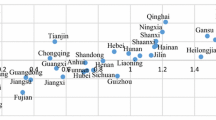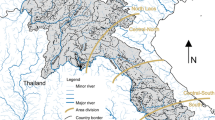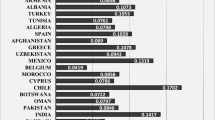Abstract
It is not easy to determine whether water is really scarce in the physical sense or whether it is available, but people cannot get access to it, or use it better. This paper reviews selected physical water scarcity indicators, and criticisms made against them on several grounds. Under the premise that the water scarcity issue is inherently multidimensional, a composite Water Poverty Index has been developed, to complement the traditional physical water indicators. In this paper we propose some technical refinements based on principal component analysis, in order to improve the method of calculation of the index. Using the proposed methodology, the present paper assesses the applicability of the index for the MENA region, by comparing the situation of oil-rich and water-poor countries (Gulf States) with that of lower-income yet water-rich countries (Horn of Africa states).












Similar content being viewed by others
Notes
It is nearly the most widely used indicator of water stress in the press.
The water availability is defined as the annual runoff available for human use.
Vörösmarty et al. (2000) developed a new index called the water reuse index which’s defined as the fraction of aggregate upstream water use relative to discharge.
The green water (generally the soil moisture and water as evapotranspiration in plants) is the main source responsible for most of the food production in many regions of the world, and as a result is substantial for human well-being.
The Human Development Index assesses the average accomplishments in a country in three main dimensions of human development such as longevity, knowledge and a decent standard of living. A composite index, the HDI hence comprises three indicators: life expectancy, educational attainment (adult literacy and combined primary, secondary and tertiary enrolment) and real GDP per capita.
In others studies, the MENA region is defined differently and contains less of countries. In this analysis, we aimed to include as many countries in the region as possible.
The Environmental Sustainability Index (ESI) is a composite index that was published from 1999 to 2005; it tracked 21 elements of environmental sustainability including natural resource endowments, past and present pollution levels, environmental management efforts, contributions to protection of the global commons, and a society’s capacity to improve its environmental performance over time.
The Principal components analysis (PCA) is a data reduction technique used to extract a smaller set of uncorrelated variables, called principal components, from a large set of correlated variables. Each principal component is a weighted linear combination of the original variables with mathematically determined characteristic vectors of the correlation matrix of the original data as weights; it can be argued that PCA can provide a good solution for the problem of arbitrary choice of weighting scheme.
Approximately 70% of water desalination projects in the world are located in the Gulf region.
References
Alcamo, J., et al. (1997) Global change and global scenarios of water use and availability: An application of WaterGap 1.0. Center for Environmental Systems Research (CESR), University of Kassel, Germany.
Alcamo, J., et al. (2003). Development and testing of the WaterGAP 2 global model of water use and availability. Hydrological Sciences Journal, 48(3), 317–338. ISSN 0262-667.
Alcamo, J., Henrichs, T., & Rosch, T. (2000). World water in 2025: Global modeling and scenario analysis for the World Commission on Water for the 21st century. Kassel world water series report no. 2, Center for Environmental Systems Research, Germany: University of Kassel, 2000, pp 1–49.
Allan, J. A. (1998). Virtual water: A strategic resource: Global solutions to regional deficits. Groundwater, 36(4), 546.
Asheesh, M. (2007). Allocating gaps of shared water resources (scarcity index): Case study on palestine-israel. Water Resources in the Middle East,2 241–248.
Brown, A., & Matlock, M. D. (2011). A review of water scarcity indices and methodologies. Arkansa: The Sustainability Consortium, University of Arkansa.
Cho, D. I., Ogwang, T., & Opio, C. (2010). Simplifying the Water Poverty Index. Social indicators research, 97(2), 257–267. ISSN 0303-8300.
Dow, K., et al. (2005). Linking water scarcity to population movements: From global models to local experiences. Stockholm: Environment Institute (SEI).
Falkenmark, M., Lundqvist, J., & Widstrand, C. (1989). Macro-scale water scarcity requires micro-scale approaches. Natural Resources Forum, 13, 258–267 (Wiley Online Library).
Feitelson, E., & Chenoweth, J. (2002). Water poverty: Towards a meaningful indicator. Water Policy, 4(3), 263–281.
Foguet, A. P., & Garriga, R. G. (2011). Analyzing water poverty in basins. Water Resources Management, 25(14), 3595–3612.
Garriga, R. G., & Foguet, A. P. (2010). Improved method to calculate a water poverty index at local scale. Journal of Environmental Engineering, 136, 1287.
Gleick, P. H. (1996). Basic water requirements for human activities: Meeting basic needs. Water international, 21, 83–92. ISSN 0250-8060.
Hair, J. F., et al. (2006). Multivariate data analysis. Englewood Cliffs, NJ: Prentice-Hall.
Hajkowicz, S. (2006). Multi-attributed environmental index construction. Ecological Economics, 57(1), 122–139.
Heidecke, C. (2006). Development and evaluation of a regional water poverty index for Benin. International Food Policy Research Institute (IFPRI), EP discussion paper 145.
Kaiser, H. F. (1974). An index of factorial simplicity. Psychometrika, 39(1), 31–36.
Komnenic, V., Ahlers, R., & Zaag, P. (2009). Assessing the usefulness of the water poverty index by applying it to a special case: Can one be water poor with high levels of access? Physics and Chemistry of the Earth, 34(4–5), 219–224.
Lawrence, P., Meigh, J., & Sullivan, C. (2002). The water poverty index: An international comparison. Keele economics Research paper, 19. Staffordshire, UK.
Malkina-Pykh, I. G. (2002). Integrated assessment models and response function models: Pros and cons for sustainable development indices design. Ecological Indicators, 2(1–2), 93–108.
Manandhar, S., Pandey, V. P., & Kazama, F. (2012). Application of the water poverty index (WPI) in the Nepalese context: A case study of Kali Gandaki river basin (KGRB). Water Resources Management, 26(1), 89–107.
Molle, F., & Mollinga, P. (2003). Water poverty indicators: Conceptual problems and policy issues. Water policy, 5(5), 529–544. ISSN 1366-7017.
Nardo, M., et al. (2005). Handbook on constructing composite indicators: Methodology and user guide. OECD Statistics Working Papers.
Ohlsson, L. (1998). Water and social resource scarcity. Rome: Food & Agriculture Organization.
Ohlsson, L. (2000). Water conflicts and social resource scarcity. Physics & Chemistry of the Earth, Part B, 25(3), 213–220.
Ohlsson, L., & Turton, A. R. (1999). The Turning of a Screw: Social Resource Scarcity as a Bottle-neck in Adaptation to Water Scarcity. London: School of Oriental & African Studies, University of London.
Oki, T., & Kanae, S. (2006). Global hydrological cycles and world water resources. Science, 313(5790), 1068.
Raskin, P., et al. (1997). Water futures: Assessment of long-range patterns and problems. Comprehensive assessment of the freshwater resources of the world (p. 23). Stockholm: Stockholm Environment Institute.
Rijsberman, F. R. (2006). Water scarcity: Fact or fiction? Agricultural water management, 80(1–3), 5–22. ISSN 0378-3774.
Rovira, J. S., & Rovira, P. S. (2008). Assessment of aggregated indicators of sustainability using PCA: The case of apple trade in Spain, Conference on Life Cycle Assessment in the Agri-Food Zurich, pp 133–143.
Salameh, E. (2000). Redefining the water poverty index. Water Resources Ass. Water International, 25, 469–473.
Savenije, H. H. G., & Van Der Zaag, P. (2000). Conceptual framework for the management of shared river basins; with special reference to the SADC and EU. Water Policy, 2(1–2), 1–37.
Smakhtin, V., et al. (2004). Taking into account environmental water requirements in global-scale water resources assessments. IWMI. ISBN 9290905425.
Shiklomanov, I. A., & Markavo O. L. (1987). Problems of water availability and water transfers in the world. Leningrad: Hydrometeoizdat.
Sullivan, C. A. (Ed.) (2000). Constructing a Water Poverty Index: A feasibility study. Centre for Ecology & Hydrology/DFID.
Sullivan, C. A. (2002). Calculating a water poverty index. World Development, 30(7), 1195–1210.
Sullivan, C. A., et al. (2003). The water poverty index: Development and application at the community scale. Natural Resources Forum, 27, (pp. 189–199). London: Butterworths.
Sullivan, C. A., Meigh, J. R., & Fediw, T. (2002). Developing and testing the Water Poverty Index: Phase 1 final technical report. Report to Department for International Development, CEH Wallingford.
Vörösmarty, C. J., et al. (2000). Global water resources: Vulnerability from climate change & population growth. Science, 289(5477), 284.
Yang, H., Reichert, P., Abbaspour, K., & Zehnder, A. (2003). A water resources threshold and its implications for food security. Environmental Science & Technology American Chemical Society, 37(2003), 3048–3054.
Author information
Authors and Affiliations
Corresponding author
Appendix
Appendix
See Table 9.
Rights and permissions
About this article
Cite this article
Jemmali, H., Sullivan, C.A. Multidimensional Analysis of Water Poverty in MENA Region: An Empirical Comparison with Physical Indicators. Soc Indic Res 115, 253–277 (2014). https://doi.org/10.1007/s11205-012-0218-2
Accepted:
Published:
Issue Date:
DOI: https://doi.org/10.1007/s11205-012-0218-2




